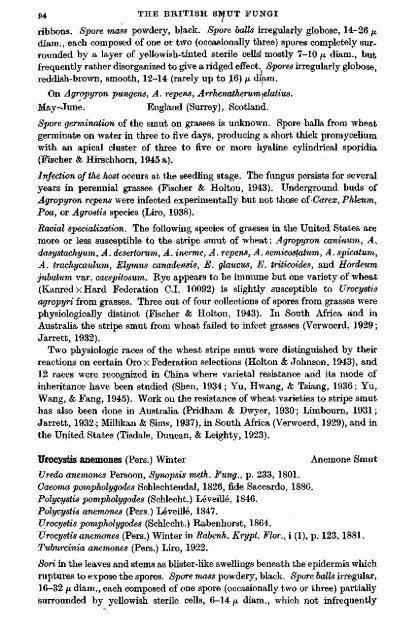nmm sP
nmm sP
nmm sP
You also want an ePaper? Increase the reach of your titles
YUMPU automatically turns print PDFs into web optimized ePapers that Google loves.
94 THE BRITISH SMUT FUNGI<br />
ribbons. Spore mass powdery, black. Spore halls irregularly globose, 14-26 jti<br />
diam., each composed of one or two (occasionally three) spores completely surrounded<br />
by a layer of yeUowish-tinted sterile cellsl mostly 7-10 /i diam., but<br />
frequently rather disorganized to give a ridged effect. Spores irregularly globose,<br />
reddish-brown, smooth, 12-14 (rarely up to 16) fj. diam.<br />
On Agropyron pungens, A. repens, Arrhenatherum\elatius.<br />
May-June. England (Surrey), Scotland.<br />
Spore germination of the smut on grasses is unknown. Spore balls from wheat<br />
germinate on water in three to five days, producing a short thick promycehum<br />
with an apical cluster of three to five or more hyahne cylindrical sporidia<br />
(Fischer & Hirschhorn, 1945 a).<br />
Infection of the host occurs at the seedhng stage. The fungus persists for several<br />
years in perennial grasses (Fischer & Holton, 1943). Underground buds of<br />
Agropyron repens were infected experimentally but not those of Carex, Phleum,<br />
Poa, or Agrostis species (Liro, 1938).<br />
Racial specialization. The following species of grasses in the United States are<br />
more or less susceptible to the stripe smut of wheat: Agropyron caninum, A.<br />
dasystachyum, A. desertorum, A. inerme, A. repens, A. semicostatum, A. spicatum,<br />
A. trachycaulum, Elymus canadensis, E. glaucus, E. triticoides, and Hordeum<br />
jubatum var. caespitosum. Rye appears to be immune but one variety of wheat<br />
(KanredxHard Federation C.I. 10092) is slightly susceptible to Urocystis<br />
agropyri from grasses. Three out of four collections of spores from grasses were<br />
physiologically distinct (Fischer & Holton, 1943). In South Africa and in<br />
Australia the stripe smut from wheat failed to infect grasses (Verwoerd, 1929;<br />
Jarrett, 1932).<br />
Two physiologic races of the wheat stripe smut were distinguished by their<br />
reactions on certain Oro X Federation selections (Holton & Johnson, 1943), and<br />
12 races were recognized in China where varietal resistance and its mode of<br />
inheritance have been studied (Shen, 1934; Yu, Hwang, & Tsiang, 1936; Yu,<br />
Wang, & Fang, 1945). Work on the resistance of wheat varieties to stripe smut<br />
has also been done in Australia (Pridham & Dwyer, 1930; Limbourn, 1931;<br />
Jarrett, 1932.; Millikan & Sims, 1937), in South Africa (Verwoerd, 1929), and in<br />
the United States (Tisdale, Duncan, & Leighty, 1923).<br />
Urocystis anemones (Pers.) Winter Anemone Smut<br />
Uredo anemones Persoon, Synopsis meth. Fung., p. 233, 1801.<br />
Gaeoma pompholygodes Schlechtendal, 1826, fide Saccardo, 1886.<br />
Polycystis pompholygodes (Schlecht.) LeveiUe, 1846.<br />
Polycystis anemones (Pers.) LeveiUe, 1847.<br />
Urocystis pompholygodes (Schlecht.) Rabenhorst, 1864.<br />
Urocystis anemones (Pers.) Winter in Rabenh. Krypt. Flor., i (1), p. 123,1881.<br />
Tuburcinia anemones (Pers.) Liro, 1922.<br />
Sori in the leaves and stems as blister-like swellings beneath the epidermis which<br />
ruptures to expose the spores. Spore mass powdery, black. Spore balls irregular,<br />
16-32 fi diam., each composed of one spore (occasionally two or three) partially<br />
surrounded by yellowish sterile cells, 6-14 fx. diam., which not infrequently

















